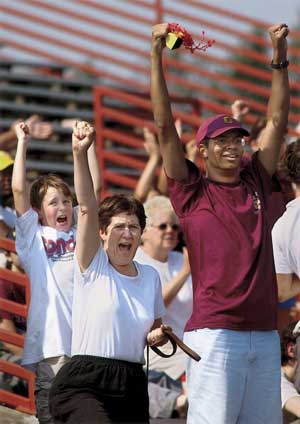|
Nancy
Dye's Presidency,
Page 5
 Maintaining
Integrity Maintaining
Integrity
When not tending to the constant needs of an active campus, Dye
lends time to the boards of a number of higher education organizations.
She chairs the board of the American Association of Colleges and
Universities and serves on the boards of Knowledge Works, an Ohio
foundation dedicated to improving educational access; the American
Council of Learned Societies; and Pomona College. In frequent demand
as a guest speaker, she was a respondent to Nobel Peace Prize Laureate
Archbishop Desmond Tutu, who spoke on racial justice and reconciliation
at a Cleveland conference series. She is an outspoken critic of
virtual higher education occurring off campus and online, and her
1997 address to the Cleveland City Club on the topic sparked national
attention. At the same time, Dye has been quick to support technological
enhancements on her own campus: every classroom, office, and dorm
room at Oberlin is wired for local network and Internet access and
the Oberlin Center for Technologically Enhanced Teaching helps bridge
the gap between technology and teaching. She still stands among
the leading scholars in women’s labor history, and she has
been recognized by the John Templeton Foundation for outstanding
leadership in the field of student character development.
Kirsch, the board member who praises Dye’s leadership, admits
that he doesn’t always see eye-to-eye with her. He doesn’t
understand, for example, why she has committed so much energy and
resources to intercollegiate athletics. “I could name many
decisions she’s made that I disagree with, but even then, I
don’t disagree with her process. She never makes decisions
because of ‘Nancy Dye’ or from undue pressure or for any
other inappropriate or illegitimate reason. She makes them because
she believes they are in the best interests of the institution.”
Last spring, Dye struggled with an incredibly difficult decision
before expelling two seniors just weeks from graduating. Each was
accused of playing a role in a premeditated assault on a student
who was asleep in his residence hall room. The alleged attackers,
both members of the football team, had been expelled by the Oberlin
College Community Board, but an appeals’ panel reduced the
punishment to suspension. The “reprehensible” assault
and the tumultuous judicial journey that followed, says Dye, ranks
as her most difficult and agonizing time at Oberlin.
“I had never seen this campus so unhappy. The more I watched
it, the worse it got. Many students and faculty came to me to talk.
I came to see the incident as a crisis of integrity for the College.”
The president, predisposed at that point to uphold the integrity
of the campus judicial process that led to the reduction in punishment,
listened earnestly.
“At a certain point, I realized that we had an institutional
crisis,’’ says Dye. “Every judicial body from time
to time makes a decision that is absolutely incomprehensible to
a lot of people. I thought the danger to this community and to its
judicial system was greater if I did not say that I would review
and decide that case. One of my roles as president is to articulate
the mission and the values of the institution when it’s appropriate
to do so. This was one of those very rare situations where I used
extraordinary authority.”
In an open letter addressed to the “Oberlin College Community,”
Dye concluded: “Oberlin at its best is a wonderfully generous,
open, and tolerant community. But the generosity, tolerance, and
openness of this unique place depend ultimately on our willingness
to protect and uphold our standards of conduct and our fundamental
values.”
The
Perfect Match
One of the keys to Dye’s success, says Koppes, is that she
seeks out people who disagree with her. “It contributes to
better decision making and consensus building, and it gives Nancy
a better sense of the overall landscape,” he says.
William Perlik ’48, former chair and current member of the
board of trustees, says that no one pushed harder than he to bring
Dye to Oberlin. She has exceeded even his admittedly stratospheric
expectations.
“I’ve seen the work of over half of Oberlin’s presidents,”
he says. “In my judgment, she is absolutely at the head of
the class. She has a magical way of working with people.
“If I have ever done anything good for Oberlin College, it
was whatever role I played in getting her here,” he adds. “Oberlin
now is as great as it has ever been.”
Kenty says that Dye understands Oberlin at its best. “She just
really gets this place. She appreciates what a quirky mix Oberlin
is—the academic excellence, the artistic pursuit, the social
activism. I can’t think of any other college or university
president who is as good of a match with their school as she is.”
Dye likes the match, too.
“I can think of a lot of very fine colleges that have good
admissions’ rates, excellent faculty, rich curricula, and wonderful
students, but wouldn’t be anywhere near as much fun to be president
of,” she says. “I really love being Oberlin’s president.
There is a lot more I would like to do here.”
“She cares. It’s that simple,” says Dodson. “One
of the remarkable attributes that Nancy brings to the presidency
is her capacity for joy.”
Mike
McIntyre is a staff writer for The Plain Dealer in Cleveland.
Go
to page 1 | 2
| 3 | 4
| 5 of Nancy Dye's Presidency
|




